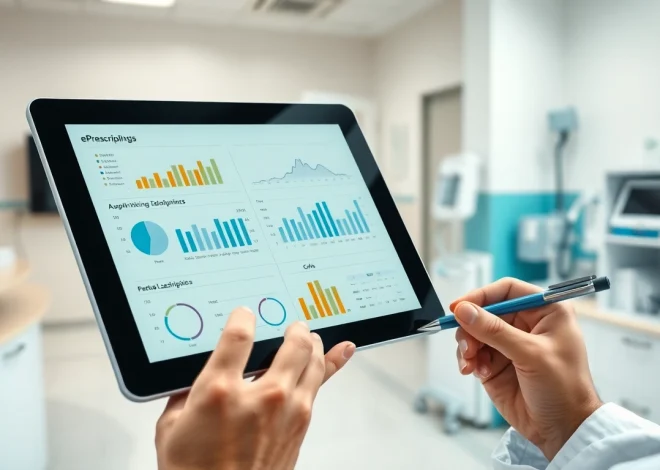
Maximize Efficiency with Apps for Electronic Prescriptions in Healthcare
Understanding Electronic Prescriptions
What Are Electronic Prescriptions?
Electronic prescriptions, commonly referred to as e-prescriptions, are digital versions of traditional paper prescriptions that allow healthcare providers to prescribe medications electronically. This method replaces hand-written prescriptions and enables prescribers to send prescriptions directly to pharmacies via secure electronic networks. E-prescribing streamlines the medication prescribing process, reducing the chances of errors that often occur with handwritten prescriptions, such as illegible handwriting or incomplete information.
Benefits of Using Apps for Electronic Prescriptions
The adoption of apps for electronic prescriptions provides numerous benefits for both healthcare providers and patients. Some of the key advantages include:
- Increased Efficiency: E-prescribing reduces the time required for writing, transmitting, and receiving prescriptions. This efficiency translates into shorter wait times for patients.
- Improved Accuracy: By eliminating handwritten prescriptions, e-prescribing minimizes errors related to dosage, drug interactions, and allergy considerations.
- Enhanced Patient Safety: E-prescribing allows for integrated clinical decision support that alerts prescribers of potential issues, including drug interactions and patient allergies.
- Cost Reduction: E-prescriptions can help reduce the costs associated with prescription errors and improve overall patient compliance, which leads to better health outcomes.
- Convenience: Patients can receive notifications when their prescriptions are ready, enhancing their overall experience and reducing pharmacy visits.
How Electronic Prescriptions Integrate with Healthcare Systems
Integrating electronic prescriptions into existing healthcare systems involves connecting e-prescribing applications with Electronic Health Record (EHR) systems. This integration allows for:
- Seamless Information Exchange: E-prescriptions can automatically pull patient information, such as medication history, allergies, and insurance details, ensuring that healthcare providers have the most up-to-date information.
- Real-Time Updates: Providers can receive real-time notifications regarding patient medication compliance and pharmacy confirmations, enhancing communication among healthcare stakeholders.
- Data Analytics: The integration allows healthcare facilities to analyze prescription data, providing insights into prescribing patterns and patient compliance trends.
Top Features to Look for in Apps for Electronic Prescriptions
User-Friendly Interfaces and Navigation
A user-friendly interface is crucial for the successful implementation of e-prescribing apps. Features to consider include intuitive navigation, accessibility options for healthcare professionals, and customizable elements that fit the workflow of different medical practices. The design should be easy to learn, ensuring that both inclined and technologically challenged users can navigate the application competently.
Compliance with Regulations and Security Standards
Given the sensitive nature of patient data, it is imperative that any e-prescribing application complies with various regulations, including HIPAA (Health Insurance Portability and Accountability Act) and other local data protection laws. The app should have robust security measures in place, such as end-to-end encryption, two-factor authentication, and secure user authentication methods.
Integration with EHR and Billing Systems
To enhance the efficacy of e-prescribing workflows, the chosen application should seamlessly integrate with existing EHR and billing systems. This integration allows for accurate and timely billing, streamlined prescription management, and a cohesive approach to patient care, ensuring that all relevant information flows seamlessly between platforms.
Comparative Analysis of Popular Apps for Electronic Prescriptions
Features and Functionalities Offered by Leading Apps
When selecting an e-prescribing app, it is essential to evaluate the various features and functionalities offered by leading competitors. Some key features to observe include:
- Prescription Tracking: Real-time monitoring of prescription status enhances communication between patients and healthcare providers.
- Drug Interaction Checks: Automated checks for drug interactions during e-prescribing help prevent potential adverse effects.
- Patient Medication History: Accessing a patient’s complete medication history aids in making informed prescribing decisions.
- Mobile Compatibility: The availability of mobile applications enables healthcare providers to prescribe medications on-the-go, enhancing flexibility and responsiveness to patient needs.
User Feedback and Ratings
User feedback is a critical component when evaluating e-prescribing apps. Analyzing ratings, reviews, and testimonials from actual users provides valuable insights into the reliability and functionality of an application. High user ratings and positive feedback often signify robust support systems, effective features, and overall satisfaction with the application.
Cost Considerations and Value for Money
Cost can vary significantly among e-prescribing applications. It’s essential to assess not only the upfront costs associated with the application but also any additional fees related to integration, training, and ongoing support. Evaluating the cost-to-value ratio is vital to ensure that healthcare organizations are investing in solutions that provide meaningful returns, such as reduced errors and increased compliance.
Best Practices for Implementing Apps for Electronic Prescriptions
Steps for Seamless Integration into Clinical Workflow
Implementing e-prescribing apps should be a structured process to maximize efficiency. Consider the following steps:
- Assessment of Current Workflow: Evaluate existing prescribing workflows to identify areas that require improvement.
- Choose the Right Application: Based on features and integration capabilities, select an application that aligns with your practice’s needs.
- Engage Stakeholders: Involve any healthcare professionals who will interact with the app in the planning and integration process to ensure their needs are met.
- Technical Setup and Integration: Work with IT teams to ensure that the app integrates smoothly with existing systems.
- Testing: Conduct thorough testing before going live to catch any potential issues early.
- Launch and Monitor: After launching, continuously monitor the system for any inefficiencies and gather user feedback for adjustments.
Training Staff and Ensuring User Adoption
Staff training is a crucial aspect of ensuring successful adoption of new technologies. Providing comprehensive, hands-on training can help users feel comfortable and confident using the new system. Consider creating detailed training materials, hosting workshops, or offering ongoing support throughout the transition period.
Monitoring and Improving E-Prescribing Efficiency
Once an electronic prescription system is in place, it is essential to monitor its effectiveness continuously. Gathering feedback from users, analyzing prescription error rates, and reviewing patient outcomes can help identify areas for improvement. Regularly updating the system and providing ongoing training can further enhance e-prescribing efficiency.
Future Trends in Electronic Prescriptions
Innovations Shaping the Future of E-Prescribing
As technology evolves, so do the capabilities and functionalities of e-prescribing applications. Among the innovations shaping the landscape are:
- Telehealth Integration: The rise of telehealth has paved the way for better integration of e-prescribing features, allowing healthcare providers to prescribe medications remotely during virtual visits.
- Advanced Data Analytics: Leveraging data analytics can provide invaluable insights that enhance prescribing practices and streamline workflow.
- Personalized Medicine: The incorporation of genetic information into e-prescribing apps may lead to more personalized medication recommendations, improving patient outcomes.
The Role of Telehealth in Electronic Prescriptions
Telehealth has significantly transformed the healthcare landscape, especially in how prescriptions are managed. E-prescribing within telehealth frameworks allows providers to prescribe medications quickly and efficiently during virtual consultations. This integration not only enhances patient convenience but also allows for more accurate assessments of treatment plans.
Impact of AI and Machine Learning on Prescribing Practices
Artificial intelligence (AI) and machine learning are poised to revolutionize the field of e-prescribing. These technologies can help analyze vast amounts of data to identify patterns in prescribing behavior, improve medication compatibility checks, and enhance patient outcomes. In the future, AI could play a pivotal role in creating personalized medication regimens that consider individual patient characteristics, leading to more effective treatments.


